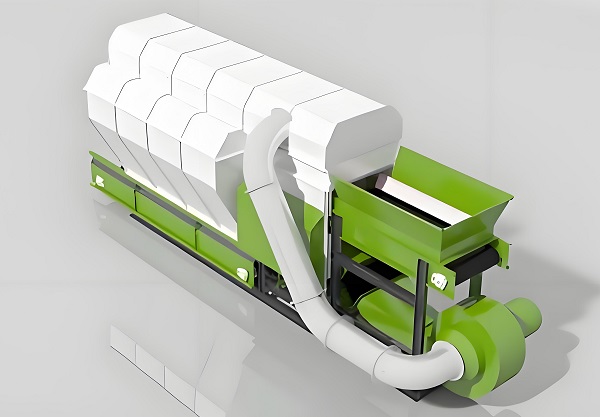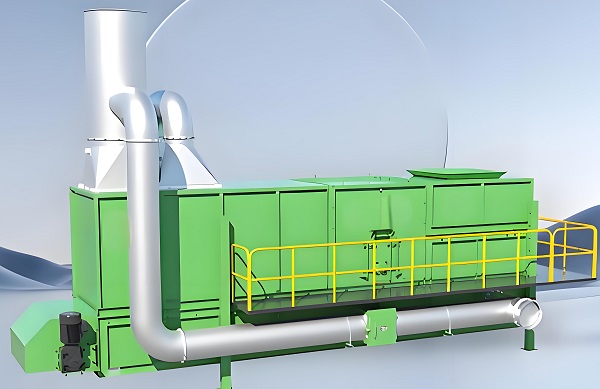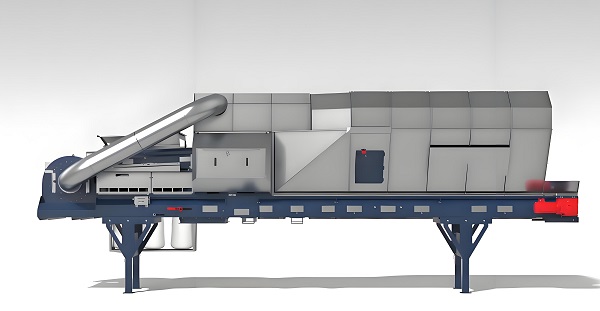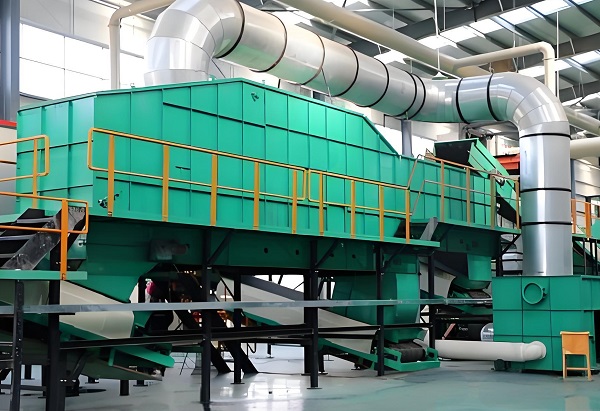Preface: In the field of industrial production, the wind sifter separator is a key separation equipment and is widely used. Its working principle is to use wind power to achieve efficient separation of different materials according to the differences in material density and particle size. From fine grain processing to mining resources, to chemical product manufacturing, the wind sifter separator plays an indispensable role. It is like a "sorting master" in the production process, ensuring the continuity and efficiency of the production process, reducing production costs and improving product quality. Therefore, the scientific and standardized maintenance and maintenance of the wind sifter separator can not only extend the service life of the equipment, but also ensure that it is always in the best operating state, laying a solid foundation for the stable production of the enterprise.

Wind Sifter Separator
A. Daily maintenance and maintenance of the wind sifter separator
1. Pre-operation inspection
Appearance inspection: Before turning on the equipment, the appearance of the wind sifter separator needs to be carefully inspected. Check whether the machine body has signs of deformation or damage, whether the bolts and nuts of the connection parts are loose, and whether the belt is worn, aged or loose. Once a problem is found in the machine body, the relevant parts should be repaired or replaced in time; if there are loose bolts and nuts, they should be tightened according to the specified torque; if the belt is abnormal, the tension should be adjusted according to the actual situation or replaced directly.
Lubrication system inspection: Carefully check whether the amount of lubricating oil at each lubrication point is sufficient and whether the oil is clear and pure. Key parts such as fan bearings and transmission bearings must be regularly replenished or replaced with lubricating oil. If the oil is found to be turbid, emulsified, or contains impurities, it is necessary to replace it with new oil immediately to ensure the lubrication effect, reduce component wear, and extend the service life of the equipment.
Electrical system inspection: Comprehensively check the electrical circuit to check whether there are hidden dangers such as damage, aging, short circuit, etc., whether the wiring of each electrical component is firm, and whether the control switch is sensitive and reliable. Once a problem is found in the electrical circuit, the circuit should be repaired or replaced in time; electrical components with loose wiring need to be re-tightened; if the control switch fails, it must be repaired or replaced.
2. Monitoring of the wind separator during operation
Temperature monitoring: During the operation of the equipment, use a thermometer or infrared thermometer to regularly measure the temperature of key parts such as the fan bearing and motor. Under normal circumstances, the fan bearing temperature should generally not exceed 70°C, and the motor temperature should not exceed the maximum temperature specified on the nameplate. Once the temperature is found to be too high, the machine should be stopped immediately for inspection to check whether there are problems such as poor lubrication, bearing damage, excessive load, etc., and take corresponding solutions in time.
Vibration monitoring: You can make a preliminary judgment by hand feel, or use a professional vibration tester to monitor the vibration of the wind separator as a whole and each component in real time. During normal operation, the vibration of the equipment should be stable and within the allowable range. If you feel abnormal vibration, or the vibration value exceeds the specified range, it may be caused by loose installation of the equipment, wear of components, imbalance, etc. At this time, you need to stop the machine for inspection and make adjustments or repairs in time.
Sound monitoring: When the equipment is running, maintenance personnel should listen carefully to the sound emitted by the equipment. During normal operation, the sound should be stable and uniform, without abnormal noise. Once you hear abnormal sounds such as impact, friction, and sharp sounds, it may mean that there are loose, falling, worn or blocked parts inside the equipment. You must stop the machine immediately for inspection, troubleshoot, and ensure the safe operation of the equipment.
3. Cleaning after the wind sifter separator is running
Material cleaning: After each operation of the equipment, the residual materials inside and outside the wind sifter separator should be cleaned in time. Compressed air or a vacuum cleaner can be used to thoroughly remove the accumulation of materials in the separation chamber, air inlet, air outlet, feeding device, etc., to prevent the material from remaining in the equipment for a long time, causing corrosion, blockage and other problems, and affecting the next separation effect.
Dust cleaning: The dust on the surface of the equipment and the surrounding environment should also be cleaned in time to keep the equipment and working area clean and hygienic. Dust not only affects the heat dissipation performance of the equipment, but may also enter the interior of the equipment and accelerate the wear of parts, so it is necessary to clean the dust regularly.

Wind Sifter Separator
B. Regular maintenance and maintenance of wind sifter separators
1. Weekly maintenance
Transmission component inspection: Check the belt transmission device every week and accurately adjust the belt tension to the appropriate range. If the belt is too loose, it will cause slippage and reduce transmission efficiency; if it is too tight, it will increase the bearing load and accelerate the wear of the belt and bearing. At the same time, check whether the pulley is worn or deformed. If there is a problem, repair or replace it in time to ensure the stable operation of the transmission system.
Fan inspection: Check whether the fan impeller is dusty, worn or deformed. Too much dust on the impeller will affect its dynamic balance and cause the vibration of the equipment to increase; impeller wear or deformation may damage the fan and affect the wind output. For dusty impellers, you can use a brush or compressed air to clean them; for worn or deformed impellers, you need to repair or replace them according to the actual situation.
2. Monthly maintenance
Lubrication system maintenance: Perform a comprehensive lubricating oil replacement for all lubrication points every month, and clean the lubricating oil circuit and filter at the same time. The newly replaced lubricating oil must meet the specifications and models required by the equipment to ensure good lubrication effect. Cleaning the lubricating oil circuit and filter can effectively prevent impurities from entering the lubrication system, ensure the cleanliness of the lubricating oil, and extend the service life of the equipment.
Electrical system maintenance: Conduct a comprehensive inspection of the electrical system, focusing on checking whether the contacts of electrical components such as contactors and relays are ablated or adhered. If so, they should be repaired or replaced in time; use an insulation resistance tester to measure the insulation performance of wires and cables. If the insulation resistance value is lower than the specified value, the cause should be found and handled, such as replacing aging wires and cables or repairing damaged insulation layers.
3. Quarterly maintenance
Complete machine performance testing: Use professional testing instruments every quarter to accurately test the performance parameters of the wind sifter separator, such as separation efficiency, air volume, and air pressure. According to the test results, adjust and optimize the equipment, such as adjusting the fan speed, changing the feed amount, and adjusting the internal structure of the separation chamber, to ensure that the equipment always maintains good working performance.
Inspection and replacement of wearing parts: Check the wear of wearing parts such as fan blades, belts, bearings, and seals. For wearing parts that are severely worn or have reached their service life, they should be replaced in time. At the same time, reserve a certain number of commonly used wearing parts so that they can be replaced in time when needed, reduce equipment downtime, and ensure production continuity.
4. Annual maintenance
Full disassembly inspection: The wind sifter separator is fully disassembled every year and each component is inspected in detail. Check whether the body structure is deformed or corroded, whether the bolts and nuts of each connection are loose or rusted, and whether the gears and chains of the transmission device are worn or broken. Any problems found should be repaired or replaced in time to ensure the overall performance of the equipment.
Equipment commissioning and calibration: After the full disassembly inspection and maintenance are completed, the equipment is reassembled, debugged and calibrated. During the commissioning process, it is necessary to ensure that all parts of the equipment operate normally and the performance parameters meet the design requirements. Calibrate the control system of the equipment to ensure that the display of each operating parameter is accurate and the equipment is put into operation in the best condition.

Wind Sifter Separator
C. Common faults and maintenance methods of wind sifter separators
1. Low separation efficiency
Cause analysis:
Insufficient wind power: It may be a malfunction of the fan, such as impeller damage, low fan speed, etc.; it may also be a blockage in the air duct, with material accumulation and debris blocking the air inlet, outlet or separation chamber.
Changes in material properties: The density and particle size distribution of the material have changed, which exceeds the applicable range of the wind sifter separator.
Improper equipment adjustment: The feed volume is too large or too small, and the internal structural parameters of the separation chamber (such as the baffle position, air flow channel size, etc.) are set unreasonably.
Maintenance method:
Check the fan, repair or replace the damaged impeller, and adjust the fan speed to the normal range; clean up the material accumulation and debris in the air duct to ensure that the air duct is unobstructed.
According to the changes in the material properties, make corresponding adjustments to the equipment, such as adjusting the wind force, changing the internal structure of the separation chamber, etc.; if the material properties change greatly and exceed the applicable range of the equipment, consider replacing a more suitable wind sifter separator.
Adjust the feed volume to the appropriate range, re-optimize the internal structural parameters of the separation chamber, determine the optimal equipment operating parameters through experiments, and improve the separation efficiency.
2. Large vibration of the equipment
Cause analysis:
The equipment is not installed firmly: the foundation bolts are loose, and the equipment is displaced or shakes during operation.
Unbalanced components: After long-term operation, the dynamic balance of rotating components such as fan impellers and pulleys is destroyed due to wear, dust accumulation, etc.
Bearing damage: After long-term use, fan bearings, transmission bearings, etc. are damaged by wear, fatigue peeling, etc. due to poor lubrication, overload, etc.
Repair method:
Check the foundation bolts of the equipment, tighten the loose bolts, re-level and align the equipment, and ensure that the equipment is firmly installed.
Perform dynamic balance test and correction on rotating components such as fan impellers and pulleys, remove dust accumulation, repair or replace severely worn components to restore dynamic balance.
Replace damaged bearings and check the lubrication system at the same time to ensure good lubrication; when replacing bearings, choose reliable products and install them according to the correct installation method.
3. Motor overheating
Cause analysis:
Excessive load: The wind sifter separator runs under high load for a long time, such as excessive feeding volume, material blockage, etc., resulting in excessive working current of the motor.
Poor heat dissipation: The motor cooling fan is damaged and the heat sink has too much dust, which affects the heat dissipation effect of the motor.
Motor failure: internal failures such as short circuit, open circuit, and bearing damage in the motor winding.
Maintenance method:
Check the operation of the equipment, adjust the feeding amount, clear the material blockage, and reduce the motor load; at the same time, check whether the transmission device is normal to ensure smooth operation of the equipment.
Repair or replace the damaged cooling fan, clean the dust on the motor heat sink, and improve the heat dissipation conditions of the motor.
Use professional electrical testing equipment to test the motor and determine the cause of the failure. For failures such as winding short circuit and open circuit, the winding can be repaired or rewound; for bearing damage, the bearing should be replaced in time.

Wind Sifter Separator
D. Maintenance and maintenance precautions for wind sifter separators
1. Safety first: Before performing maintenance and maintenance work, the power supply of the equipment must be cut off first, and a warning sign of "No closing, someone is working" must be hung to prevent accidental power-on from causing casualties. Maintenance personnel should wear personal protective equipment, such as safety helmets, protective gloves, goggles, etc., to ensure their own safety.
2. Use appropriate tools: During maintenance and maintenance, tools that meet the requirements should be used to avoid using inappropriate tools to cause damage to components or affect the quality of maintenance. For example, when removing and installing bolts, a wrench of appropriate specifications should be used to avoid excessive force that may cause the bolts to be stripped or broken.
3. Follow the operating procedures: Strictly follow the equipment's maintenance and repair operating procedures, and do not arbitrarily change the operating steps or omit necessary links. When replacing parts, ensure that the model and specifications of the new parts are consistent with the original parts, and install them according to the correct installation method.
4. Keep records: After each repair and maintenance work is completed, the time, content, replaced parts, equipment operating parameters and other information of the repair and maintenance should be recorded in detail. These records not only help track the equipment's maintenance history, but also provide important basis for subsequent equipment management and fault diagnosis.
PS: The repair and maintenance of the wind sifter separator is a systematic and long-term work, which requires operators and maintenance personnel to have professional knowledge and skills and to operate in strict accordance with relevant requirements and specifications. Through scientific and reasonable daily maintenance and regular maintenance and maintenance, timely discovery and resolution of problems that occur during the operation of the equipment can effectively extend the service life of the wind sifter separator, improve the equipment's operating stability and separation efficiency, and provide strong guarantees for the smooth progress of industrial production. At the same time, during the repair and maintenance process, we must always bear in mind the principle of safety first, take various safety precautions, and ensure the safety of personnel and equipment.
Save Time! Get A Detailed Quotation Quickly.
